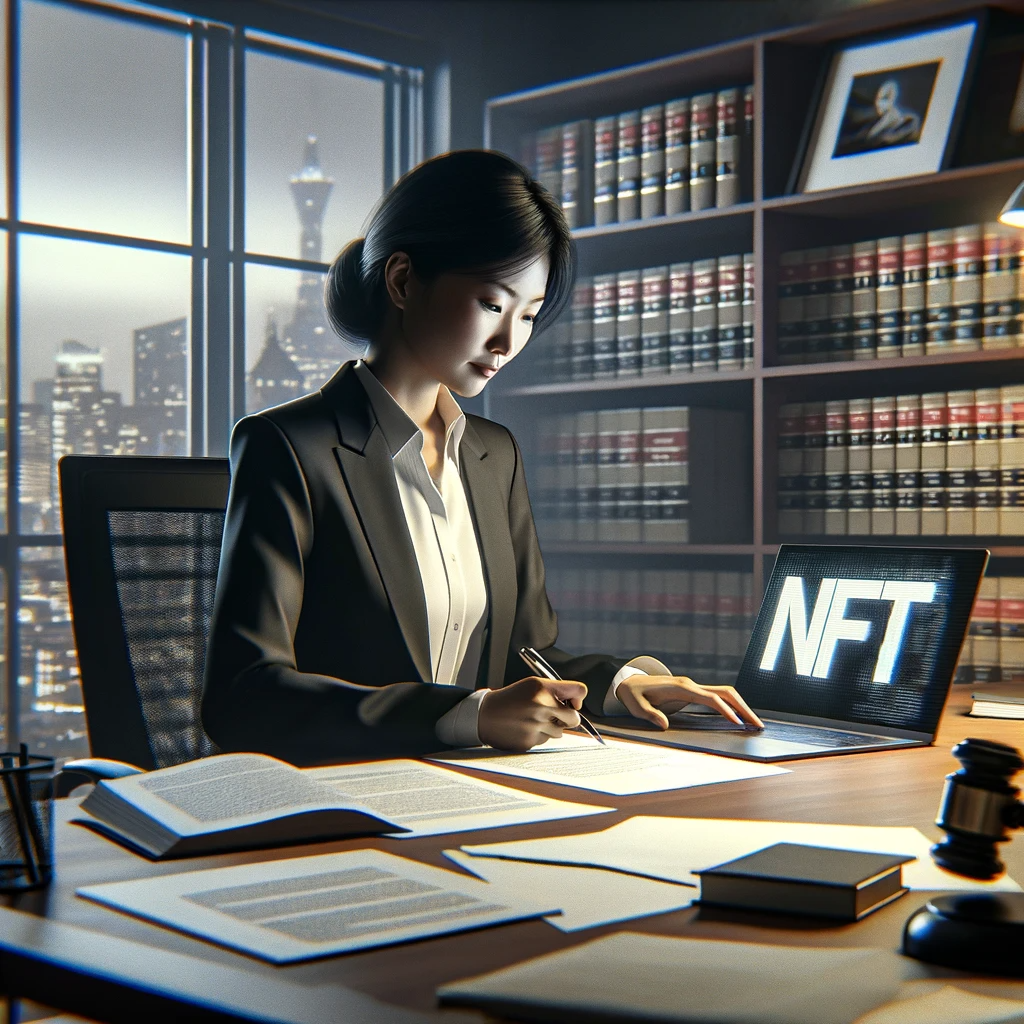How to Convert a JPG to a Stunning NFT in 6 Simple Steps?
The world of art has undergone a transformative shift with the coming of NFTs. Changing how we interact with digital assets, NFT offers abundant opportunities for artists, collectors, and investors. As of today, the market value of the NFT industry sits at a whopping $6.16 billion.
If you possess a digital asset, such as a JPG, and desire to transform it into an NFT, this article will provide the complete guidance to accomplish your objective. As you’ll explore the world of NFTs, you will see:
- The basic NFT concepts
- 6 practical steps that you can follow to convert a picture to NFT
- Discover the diverse possibilities for NFT utilization

Understanding what is an NFT?
Non-fungible tokens, commonly referred to as NFTs, stand as a distinct category of digital assets denoting ownership of a particular item, artwork, or content through the application of blockchain technology.
NFTs possess indivisibility and differ from conventional cryptocurrencies like Ethereum because they are not interchangeable on a one-to-one basis. Each NFT has a distinct value and identity, making them particularly valuable for artists, collectors, and creators seeking to establish ownership and provenance in the digital world.
The Appeal of Converting JPGs to NFTs
Converting any digital images, particularly JPGs, into NFTs lies in the ability to monetize and authenticate digital art or collectibles. By tokenizing these images on blockchain, artists and creators can prove their originality, scarcity, and ownership, making them attractive to collectors and investors.
This process not only opens up new revenue streams for artists but also offers collectors a chance to own unique digital assets and participate in a digital art market, which has gained significant popularity and attention in recent years. The digital art market is $14.38 billion as of 2022 and is expected to grow to $23.79 billion by 2030.

Step 1: Creating or Sourcing Your JPG Artwork
The journey of converting a JPG into an NFT begins with the creation or sourcing of the digital artwork that you wish to tokenize. This step sets the foundation for your NFT project and influences its potential value.
1. Creating Your Digital Art
For artists and creators, crafting original digital artwork offers a unique opportunity to express their creativity, build a brand around their unique style, and allow potential buyers to connect with your creation more deeply. Consider the following when creating your digital art:
- Uniqueness: Strive for originality in your work.
- Quality: Pay attention to details, colour schemes, and overall aesthetics.
- Storytelling: Explain your inspiration and process in your NFT listing.
2. Sourcing Existing Digital Art
Only some have the ability or desire to create original digital art. In such cases, sourcing existing digital artwork from fellow artists or the public domain is a common practice. However, it’s essential to be mindful of copyright and licensing issues. If done correctly, commissions remain a significant source of income, ranging from 10-30% of total sale value.

Step 2: Preparing Your JPG for the NFT Conversion
Once you’ve created or sourced your digital artwork, the next step is preparing your JPEG image file for the NFT conversion process. This step involves several considerations:
1. Image Quality
The resolution, clarity, and overall aesthetics of your digital art greatly influence its value and appeal. High-resolution images are more likely to attract collectors and investors, as they can appreciate the fine details of your work.
2. Metadata
Metadata is the information embedded within your digital file. NFT marketplaces typically allow you to add metadata to your NFT, including title, description, tags, and any relevant information about your artwork.
3. Digital Signatures
Some artists add digital signatures or watermarks to their work for authentication. While this can enhance security and prove the origin of the art, it’s essential to balance the visibility of these elements with the aesthetic appeal of the image.
4. File Compression
To minimize the size of your JPG and ensure efficient uploading and storage on the blockchain, you might need to compress your image. Be cautious not to over-compress, as this can result in losing image quality.
5. Ownership and Rights
Establish ownership and rights related to your digital art. If you’re the creator, ensure you have the right to sell and tokenize the artwork as an NFT. If you sourced the artwork from another artist, ensure you have the licenses and permissions to proceed.
6. Digital File Backup
Always maintain a secure backup of your original digital file. The blockchain provides a secure ledger for your NFT, but your original digital art should be safely stored in the event of unforeseen circumstances.
7. Aesthetic Presentation
Consider how your digital art will be visually presented on the NFT marketplace, such as the thumbnail image, as this is often the first thing potential buyers see.

Step 3: Choosing the Right NFT Marketplace
Once you’ve prepared your digital artwork, the next significant step in turning a JPG to an NFT is selecting the right NFT marketplace to list and sell your NFT.
1. Marketplace Reputation and Credibility
Begin by researching and evaluating the reputation and credibility of NFT marketplaces. opt for well-established, reputable platforms with a history of secure and transparent transactions.
2. Supported Blockchains
The blockchain you choose can influence factors like transaction costs and audience reach. Ethereum is currently the most widely used blockchain for NFTs, but other blockchains are gaining popularity for their scalability and lower gas fees.
3. Platform Fees
Be aware of the fees associated with minting and listing your NFTs on the platform. These fees can vary significantly between marketplaces. Consider your budget and weigh the costs against the potential benefits and audience reach of the forum. The cost of minting can dramatically range from $0.05 to over $150.
4. Audience
Different NFT marketplaces attract distinct audiences. Consider the interests and size of the user community on each platform. Choose a marketplace that aligns with your target audience and creative niche.
5. Licensing and Terms of Service
Read and understand the licensing and terms of service of the NFT marketplace. Ensure you’re comfortable with the platform’s policies regarding intellectual property rights, royalties, and other legal considerations.
6. Royalties
Examine the marketplace’s policies regarding secondary sales. Many NFT platforms allow creators to set royalties on secondary sales, enabling you to earn a percentage every time your NFT changes hands. Typical royalties for NFTs are between 4%-10%.
7. Security Measures
The platform’s security is critical, as it will protect both your NFT and the personal information associated with your account. Look for marketplaces with solid security measures.

Step 4: Setting Up a Digital Wallet
Before you can mint and list your NFT on your chosen marketplace, you must set up a digital wallet. A digital wallet is essential for managing your NFTs, receiving payments, and participating in the NFT ecosystem.
1. Select a Compatible Wallet
You’ll need to choose a wallet that works seamlessly with the platform where you intend to list your NFT. Ethereum-based NFTs are among the most common, so wallets compatible with Ethereum, such as Meta Mask and Trust Wallet, are widely used.
2. Install and Set Up Your Wallet
Once you’ve chosen a compatible wallet, install it on your device. Follow the setup instructions provided by the wallet provider. This usually involves creating a secure password, storing recovery phrases safely, and linking your wallet to your device.
3. Fund Your Wallet
To mint an NFT, you’ll need a small amount of cryptocurrency in your wallet to cover the gas fees associated with the transaction. Ensure your wallet is adequately funded, and understand how to transfer cryptocurrency to and from your wallet.
4. Security Measures
Digital wallets are gateways to your NFTs and cryptocurrencies, making security essential. Take these precautions:
- Enable two-factor authentication (2FA) to add an extra layer of security to your wallet.
- Keep your wallet software up to date to protect against vulnerabilities.
- Safeguard your private keys and recovery phrases offline, ideally in physical form. Never share them with anyone.
- Be cautious of phishing and scams, and only use official wallet websites and apps.
5. Backup and Recovery
Back up your wallet’s private keys and recovery phrases securely. These are your lifelines to recover your wallet in case of loss or damage. With them, you can gain access to your NFTs and funds.
6. Wallet Connectivity
Your wallet should connect to the NFT marketplace where you intend to list your NFT. Test this connectivity to ensure it works correctly.
7. Multiple Wallets and Ledger Devices
For added security and organization, consider using multiple wallets or hardware wallet devices. This separation can help protect your assets and streamline the management of different NFT collections.

Step 5: Minting Your NFT
Minting your NFT is the pivotal step that transforms your digital artwork into a blockchain-based asset, confirming its uniqueness, authenticity, and ownership.
1. Sign In and Connect Your Digital Wallet
Log in to your NFT marketplace account and connect your digital wallet. This linkage allows you to mint your NFT directly from your wallet and manage it on the platform.
2. Create a New NFT Listing
Within the NFT marketplace, start the process of creating a new NFT listing. You’ll be prompted to upload your JPG and provide essential information about your NFT. This includes details such as the title, description, tags, and any unlockable content or attributes associated with your NFT.
3. Royalties and Resale Rights
You have the option to set royalties for your NFT. This means that you can specify a percentage of the resale value that you will receive whenever your NFT changes hands in the future. Royalties provide an ongoing revenue stream, even after the initial sale.
4. Mint Your NFT
Once you’ve completed the necessary information, proceed to mint your NFT. This process writes your unique digital asset to the blockchain, confirming its authenticity and ownership. It may also involve paying gas fees associated with blockchain transactions. Gas fees vary greatly; sometimes, the difference can be from 100% to 1000%.
5. Confirmation and Review
After minting, your NFT is live on the marketplace. Review your listing to ensure all the details are accurate and the artwork displays as intended. Some marketplaces allow you to set your NFT as an auction or fixed-price sale.
6. Publish Your NFT
Once satisfied with your NFT listing, publish it to the marketplace for potential buyers and collectors to view and purchase. Share your NFT listing on social media or within your network to maximize visibility.

Step 6: Listing and Selling Your NFT
Now that you’ve successfully minted your NFT and its life on the marketplace, the next step in converting a JPG to an NFT is to manage the listing and facilitate its sale.
1. Promote Your NFT
Start by promoting your NFT listing to generate interest and increase its visibility. Please share it on social media platforms, art communities, and within your network.
2. Choose a Sales Strategy
Determine your preferred sales strategy for your NFT. NFT marketplaces typically offer two primary options:
- Fixed Price: Set a specific price at which your NFT can be purchased instantly.
- Auction: Allow potential buyers to bid on your NFT over a defined period. The highest bidder at the end of the auction wins the NFT.
3. Price Your NFT Appropriately
Pricing your NFT can be challenging. Consider factors such as the uniqueness of your digital artwork, your reputation as an artist, and the current market conditions. Remember to value your work, but remain realistic about your target audience’s willingness to pay. The majority of NFTs are sold below the $200 mark.
4. Engage with Potential Buyers
Actively engage with potential buyers and collectors who express interest in your NFT. Answer their questions, provide additional information about your artwork, and consider any reasonable offers.
5. Manage Your Listing
Frequently check the status of your NFT listing. Monitor any bids, offers, or inquiries and respond promptly. Ensure that the listing remains live throughout the sales process.
6. Secure the Transfer of Funds and NFT
When a buyer successfully acquires your NFT, confirm the secure transfer of the NFT and the corresponding payment. Depending on the marketplace, this process can be automated. Ensure the funds are transferred to your wallet and the NFT to the buyer’s wallet.
7. Maintain Legal and Ethical Considerations
Ensure you have the rights to sell the digital artwork and comply with any copyright, licensing, or intellectual property requirements. Be transparent about your rights as the creator.
8. Deliver the NFT and Ownership Rights
After the sale, transfer the NFT to the buyer’s wallet and confirm the transfer of ownership rights. This finalizes the deal, and the buyer becomes the new owner of the NFT.
9. Promote Your Success
Once you’ve successfully sold your NFT, consider sharing the achievement with your network and NFT community. This creates a positive reputation as an NFT creator.

Legal and Copyright Considerations
In the realm of Non-Fungible Tokens (NFTs), understanding the legal landscape and copyright considerations is paramount. Artists and creators must ensure they have the appropriate rights and permissions for the digital assets they tokenize as NFTs to avoid copyright infringement issues.
Additionally, respecting licensing agreements and intellectual property rights is crucial in this evolving space, where disputes and legal challenges related to ownership and authenticity can arise.
Risks and Challenges of NFT Conversion
While the NFT market has seen significant growth and attention, it has inherent risks and challenges. These include potential copyright infringements, the environmental impact of energy-intensive blockchains, market volatility, oversaturation, scams, and the limited utility of some NFTs.
Navigating these risks requires informed decision-making, technological proficiency, and an understanding of the unpredictable nature of the market.
Conclusion
Within the NFT landscape, the mixture of art, technology, and finance has redefined our perspectives on and how we trade digital assets. NFTs provide distinctive prospects for artists, innovators, and collectors; however, they simultaneously pose challenges, including copyright issues, market unpredictability, and the ecological consequences of blockchain technology.